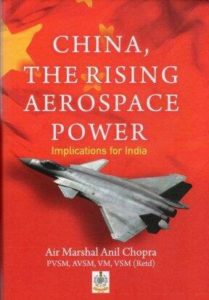24: Book Review : China-The rising aerospace power: Implications for India
While the USA would like to have a unipolar world, and bi-polar Asia, China wants to have a Bi-polar world and Uni-polar Asia. India would soon be the third most powerful world power and would prefer a multipolar world.

Overall it is a very comprehensive research work covering all aspects related to a very relevant subject.
Review by: Air Marshal Anil Khosla (Retd)
Continue reading “24: Book Review : China-The rising aerospace power: Implications for India”
19: CHINA THROUGH USA PRISM (Indo – China Perspective) Part – 2
Part 1: China’s National Strategy
Initial part of the recently published Annual Report to US Congress on military and security developments involving the people’s republic of china deals with understanding Chinese National Strategy. Foreign and economic policies are important part of it.
Aspects related to China’s Foreign Policy
Excerpt from US Report. The PRC’s foreign policy seeks to revise aspects of the international order on the Party’s terms and in accordance with ideas and principles it views as essential to forging an external environment conducive to China’s national rejuvenation.
Comments. China’s foreign policy is very aggressive and belligerent in nature. Her actions and behavior in the last few months is an indicator of things to come in future. Some aspects related to her foreign policy are as follows:
-
- China deals with foreign policy in same way she deals with domestic dynamics, politics and situations.
-
- In China’s view other countries are either subordinates or inimical. There is no third category.
-
- She prefers bilateral dealings rather than multilateral ones.
-
- China has only interests and no friends.
Excerpt from US Report. In 2019, the PRC recognized that its armed forces should take a more active role in advancing its foreign policy, highlighting the increasingly global character that Beijing ascribes to its military power.
Comments. In China the PLA belongs to the Party and she uses the armed forces to rule the country. She has started using the armed forces as a tool for foreign policy as well. She is using them extensively for coercive diplomacy by offensive posturing and muscle flexing. In tune with her global aspirations, she is investing more on her Air Force, Navy and long range vectors.
Aspects related to China’s Economic Policy
Excerpt from US Report. The CCP prioritizes economic development as the “central task” and the force that drives China’s modernization across all areas, including its armed forces.
Comments. China’s economic rise in last decade or so is commendable. Other relevant aspects are as follows:
-
- China’s main strength is her ability to produce goods cheaper than elsewhere. China is also called the Factory of the world. She entered the top ten exporters list by end of last decade and within a span of ten years reached the top spot.
-
- The rest of the world is responsible for this, as all the major production houses from world over have industrial production units in China.
-
- In the last six months China has made too many enemies and the world has realized its mistake. The decoupling process has already commenced and would happen in spite of being a difficult process. This would hurt the Chinese economy to a large extent.
Excerpt from US Report. China’s economic development supports its military modernization not only by providing the means for larger defense budgets, but through deliberate Party-led initiatives such as OBOR and Made in China 2025, as well as the systemic benefits of China’s growing national industrial and technological base.
Comments. This observation by US has many aspects as follows:
-
- It is true that the military modernization of China commenced after improvement in her economic status.
-
- China has been spending a lot on the modernization of her military. Exact amount cannot be assessed for sure as her stated figures are not trustworthy.
-
- OBOR or BRI is a beneficial project for China in many ways. She can use her surplus infrastructure building capacity to good use. She can control the participating countries by trapping them in heavy debts. While reviving the trade routes China would get much needed alternative supply routes.
-
- The project is already facing roadblocks in many places. The project is likely to get adversely affected further due to the change in world opinion about China’s role in the pandemic situation and her opportunistic behavior thereafter.
-
- China has a good technology and industrial base developed by unscrupulous methods of industrial espionage and reverse engineering. Various countries having realized this and have already initiated corrective actions.
Please feel free to express your views and provide value addition.
Part 3 of the series would cover the aspects related to Military-Civil Fusion (MCF) Development Strategy.
The Article has also been published at India Narrative
